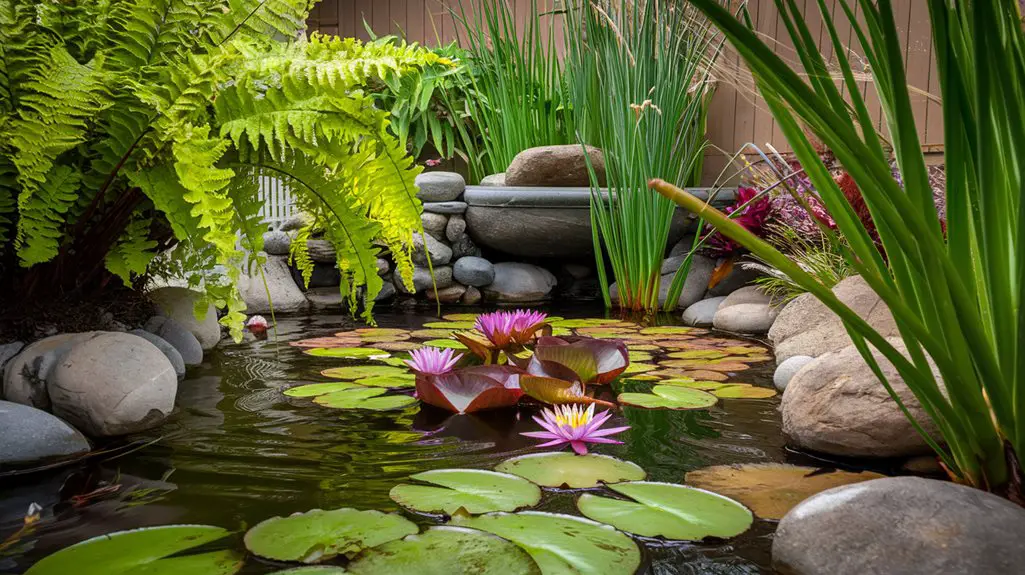If you're looking to create a tranquil oasis in your backyard, choosing the right plants for your water feature is essential. Water lilies and lotus flowers can add stunning visuals, while cattails enhance both beauty and biodiversity. Consider vibrant marsh marigolds and elegant Japanese irises to bring seasonal color and attract pollinators. But what about those lesser-known plants that can truly elevate your water garden? Let's explore some top contenders that might surprise you.
Water Lilies
When you imagine a serene water feature, water lilies likely float to the forefront of your mind.
These stunning aquatic plants add a touch of elegance and tranquility to any pond or fountain. Their broad, round leaves provide perfect floating surfaces, while their vibrant blooms create a striking contrast against the water's surface.
Water lilies thrive in full sun and can be found in various colors, from soft pastels to vivid hues. You can choose hardy varieties for cooler climates or tropical ones for warmer regions.
Plant them in a shallow area, ensuring they're submerged just right. With proper care, these lovely flowers won't only beautify your space but also attract beneficial wildlife, enhancing your water feature's ecosystem.
Lotus Flowers
Lotus flowers, with their striking blossoms and unique ability to rise above murky waters, can transform any water feature into a breathtaking scene.
These aquatic beauties thrive in warm climates and can be planted directly in ponds or large containers. Their large, rounded leaves float gracefully on the surface, providing shade for fish and creating a serene atmosphere.
Depending on the variety, lotus flowers bloom in vibrant colors, ranging from soft pinks to brilliant whites, adding a pop of color to your landscape.
To grow successfully, make sure they receive full sun and maintain a stable water level. Additionally, incorporating water features into your garden can attract various wildlife, enhancing the overall ecosystem of your backyard oasis.
With minimal care, you'll enjoy stunning blooms throughout the summer, making your water feature a focal point of beauty and tranquility.
Cattails

Although often overlooked, cattails are an essential addition to any water feature, offering both beauty and ecological benefits.
These tall, slender plants create a stunning backdrop, swaying gracefully in the breeze. Plus, they serve important functions that enhance your backyard ecosystem.
Here are three reasons to include cattails in your water feature:
- Wildlife Habitat: Cattails provide shelter and food for various birds, insects, and aquatic life, promoting biodiversity in your garden.
- Water Filtration: Their roots help filter pollutants from the water, contributing to a healthier environment for fish and other aquatic inhabitants.
- Erosion Control: Cattails stabilize the soil around your water feature, reducing erosion and keeping your landscape intact.
Incorporating cattails will elevate your backyard's charm and functionality! Furthermore, these plants are known to significantly increase property value, making them a wise investment for any homeowner.
Marsh Marigold
If you're looking to add a splash of vibrant color to your water feature, consider the marsh marigold. This perennial plant thrives in wet, boggy areas and produces stunning yellow flowers that bloom in early spring, lighting up your garden like nature's own fireworks.
With glossy, heart-shaped leaves, it not only enhances visual appeal but also adds texture to your landscape. Marsh marigolds attract pollinators, too, making them a great choice for supporting local ecosystems. They are also beneficial for creating wildlife habitats, as they provide food and shelter for various species.
They prefer partial shade and moist soil, so place them near the edges of your pond or stream. Just be sure to keep them contained, as they can spread easily.
With their cheerful presence, marsh marigolds will surely elevate your water feature's charm!
Japanese Iris

When you want to introduce a touch of elegance to your water feature, the Japanese iris is an exquisite choice.
These stunning flowers bloom in a variety of colors, adding beauty and sophistication to your landscape. Here's why you should consider planting them:
- Visual Appeal: Their large, delicate petals and unique shapes create a striking contrast against the water, enhancing your feature's overall beauty.
- Adaptability: Japanese irises thrive in moist environments, making them perfect for ponds or bog gardens, where their roots can soak up the water.
- Seasonal Interest: Blooming in late spring to early summer, they provide vibrant color when many other plants have yet to flower, ensuring your water feature stays lively.
Additionally, they are known to attract wildlife-friendly species, which can enhance the ecological balance of your garden.
Choose Japanese iris for an enchanting, serene atmosphere in your backyard oasis!
Pickerel Rush
One standout option for enhancing your water feature is Pickerel Rush, a hardy aquatic plant that thrives in shallow waters.
This vibrant perennial boasts stunning blue to purple flowers that bloom from late spring to early summer, adding a splash of color to your landscape. Its long, strap-like leaves create a lush backdrop, providing habitat for local wildlife, including frogs and dragonflies.
Pickerel Rush is low-maintenance and can tolerate various water conditions, making it an ideal choice for beginners. You'll love how it naturally filters the water, promoting a healthy ecosystem. Additionally, it is considered one of the eco-friendly water features that can enhance biodiversity in your garden.
Just plant it in 2 to 12 inches of water, and watch it flourish, transforming your backyard into a serene oasis.
Conclusion
So, if you're dreaming of a backyard oasis that's more 'Zen garden' than 'swampy mess,' it's time to embrace these top plants. Water lilies and lotus flowers will add a touch of elegance, while cattails and marsh marigolds keep things lively. Who knew you could host a wildlife party while beautifying your yard? Just remember, if your water feature starts resembling a scene from a horror movie, it might be time to reconsider your plant choices!




